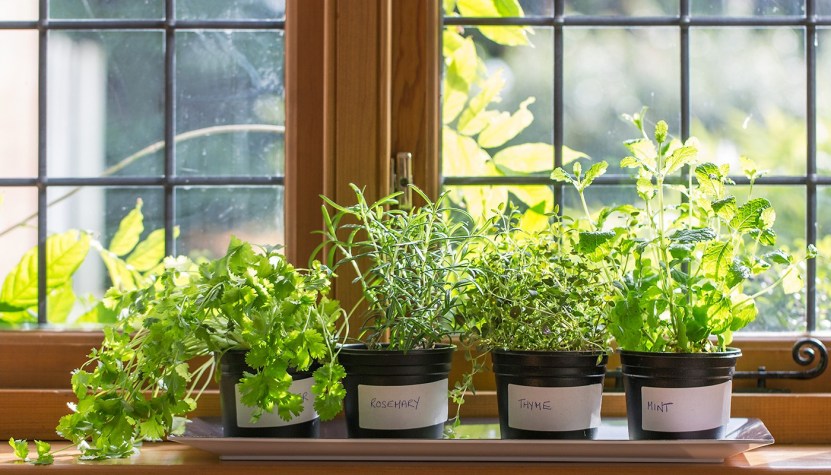New Page
Thursday, July 2, 2020 - 7 tips for planting a food garden

The City of Brampton, Ontario recently launched Canada’s first city-wide backyard garden program, designed to help alleviate food insecurity in the area due to the COVID-19 pandemic. The initiative encourages citizens to grow vegetables, herbs, and fruit outdoors and donate their harvest to local food banks. The Brampton Backyard Garden Program supports residents with free soil and seeds, along with tutorials and gardening tips.
“Gardening has the potential to build communities,” says Toronto gardener and author Steven Biggs, who has written several books about food gardens.
Here’s how you can create a food garden, whether you have a small patio, sunny spot in front of your house, or a sprawling backyard.
Create a container food garden on your patio
Many edibles do very well when grown in pots, says Biggs, and there are plenty of dwarf varieties of plants to choose from.
“I always recommend leafy greens, because they’re easy to grow in containers, and they do well in partial sun,” he says. “Tomato varieties are really great, too. Just make sure you pick things that you’ll enjoy eating.”
If you want to grow lots of food, you can start from a seed indoors, or outdoors when the ground has completely thawed— but if you’re just doing one or two tomato plants, it makes more sense to buy seedling plants instead.
“Don’t feel like you’re cheating if you buy a plant somebody else has grown,” says Biggs.
If you’re growing produce for your community, some of the faster-growing options include salad greens and spinach. Even if your property only gets four or five hours of sun a day, you can still grow plenty of delicious vegetables like carrots, beets, garlic and kale that can make a real difference.
Lacking space? Look up!
Homeowners and condo dwellers can also grow edibles efficiently, thanks to vertical gardening. For example, you can plant shallow-rooted plants like strawberries, radishes and herbs in gutters and hang them along a fence.
“I’ve seen people grow vining plants from a balcony box, either growing them down or to the side,” says Biggs. “It’s a fantastic idea in an urban setting to make the use of your space.”
Try vining produce like cucumbers, pole beans, summer squash or melons.
Get the kids involved
Looking for a family-friendly backyard project that also teaches children about where their food comes from? Let them decide what to plant.
“See what interests them; I have one child who just loves bugs, another who is really fascinated with birds, and another who loves plants and tomatoes; different kids will be attracted to different things in the garden,” says Biggs, who wrote Gardening With Emma, a kid-to-kid guide to planting food.
“That could translate into a bug-themed garden or plants to attract birds. Or you can do fun projects like a garden teepee that you grow pole beans on or maybe a sunflower house hideout.”
Set up some straw bales
For people living in urban areas with no green space at all, take a second look at your driveway or the alleyway between your home and your neighbours’; it’s the perfect spot for a straw bale food garden.
“I’ve been doing straw bale gardening for three years, and I’m excited about it because it’s a really easy, quick way to start: The bale is both your growing medium and your container,” says Biggs.
Three to four weeks before you plant, water your bales and add fertilizer so it starts to decompose. Then, plant right into the bale.
“I’ve turned half of my driveway into a temporary garden with tomatoes, peppers, beans and flowers,” says Biggs. “It’s a fantastic pop-up garden if people don’t want to invest a lot in permanent infrastructure like raised beds. You can also put bales on a patio.”
Don’t forget your front yard
If you have more space or sun out front, Biggs suggests planting your food garden there.
“When you use that space, there’s a whole community aspect to it,” he explains. “I’ve met more people with my front yard veggie garden than I had in previous years living on my street.”
You may even want to put up signs in the garden so people can harvest some of your prolific edibles like mint or chives.
How to handle pests
Your edible garden can be an outdoor buffet to local wildlife, and many homeowners prefer not to spread pesticides everywhere, says Biggs.
“Squirrels and raccoons can get into all sorts of spaces unless you physically exclude them, and you can do that with wire mesh when you’re gardening on a smaller scale,” says Biggs. “But sometimes you just have to accept that you’re going to share, so grow things like currents, cherry tomatoes or smaller fruits that are really prolific. This way, there’s lots for you, and for the birds and squirrels.”
No yard? No problem!
Even if you don’t have a yard, patio or balcony, you can still grow food on a windowsill, suggests Biggs.
“If someone in an apartment or a condo without a yard thinks they can’t grow food, well, you can,” he says. “You can grow microgreens: Just use a pie plate, add some potting soil and dried peas from the grocery store and grow them into little edible green pea sprouts.”
You can also use kitchen scraps such as romaine lettuce ends, celery and fennel to grow food or purchase a soil-free countertop AeroGarden kit.
Source CREA cafe May 2020